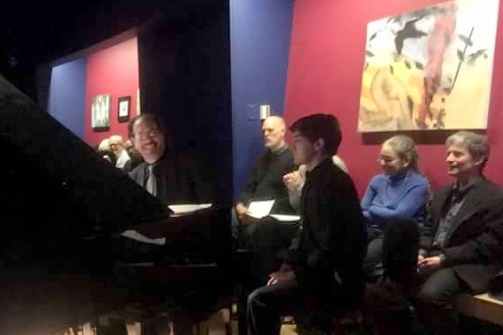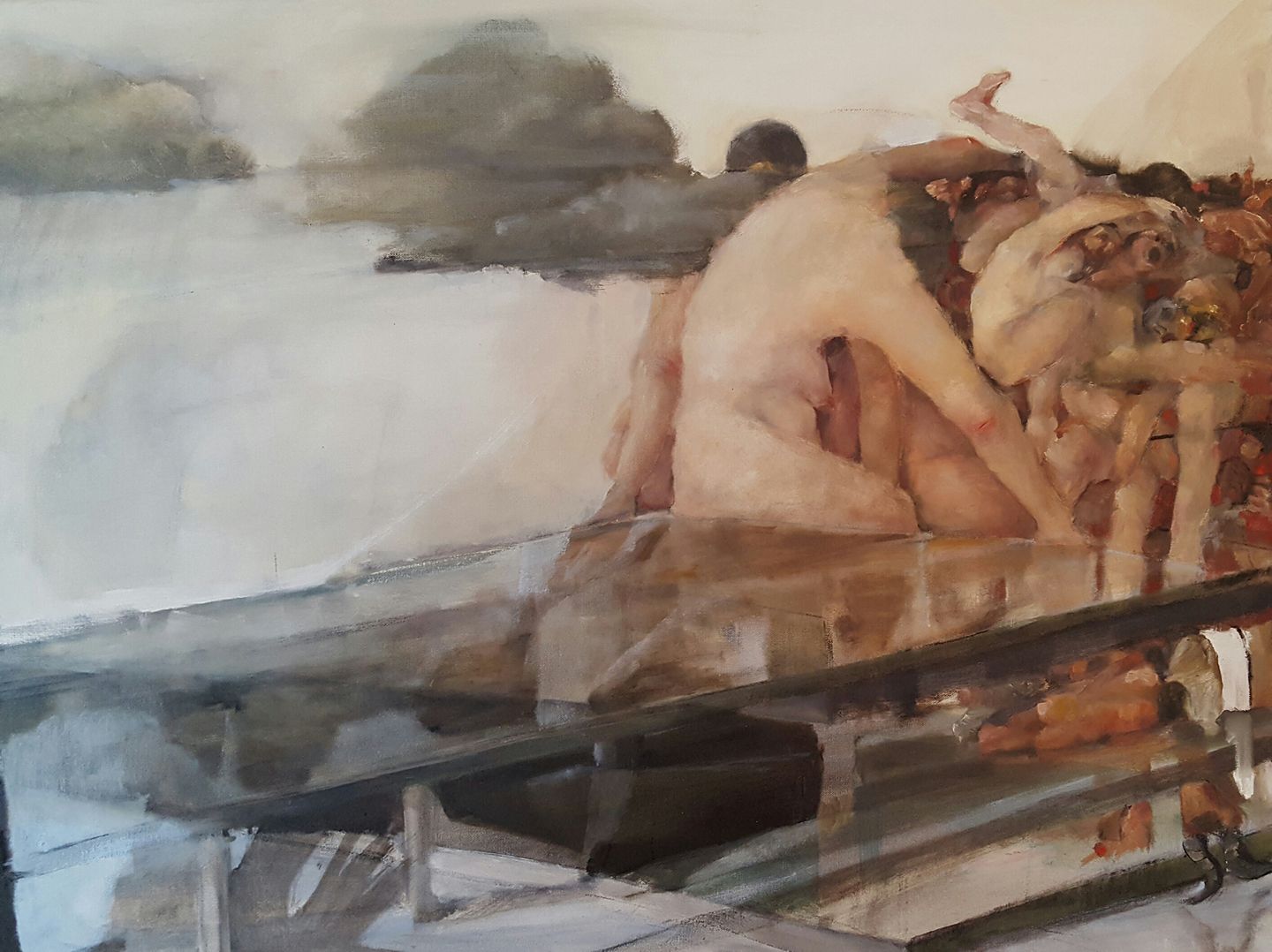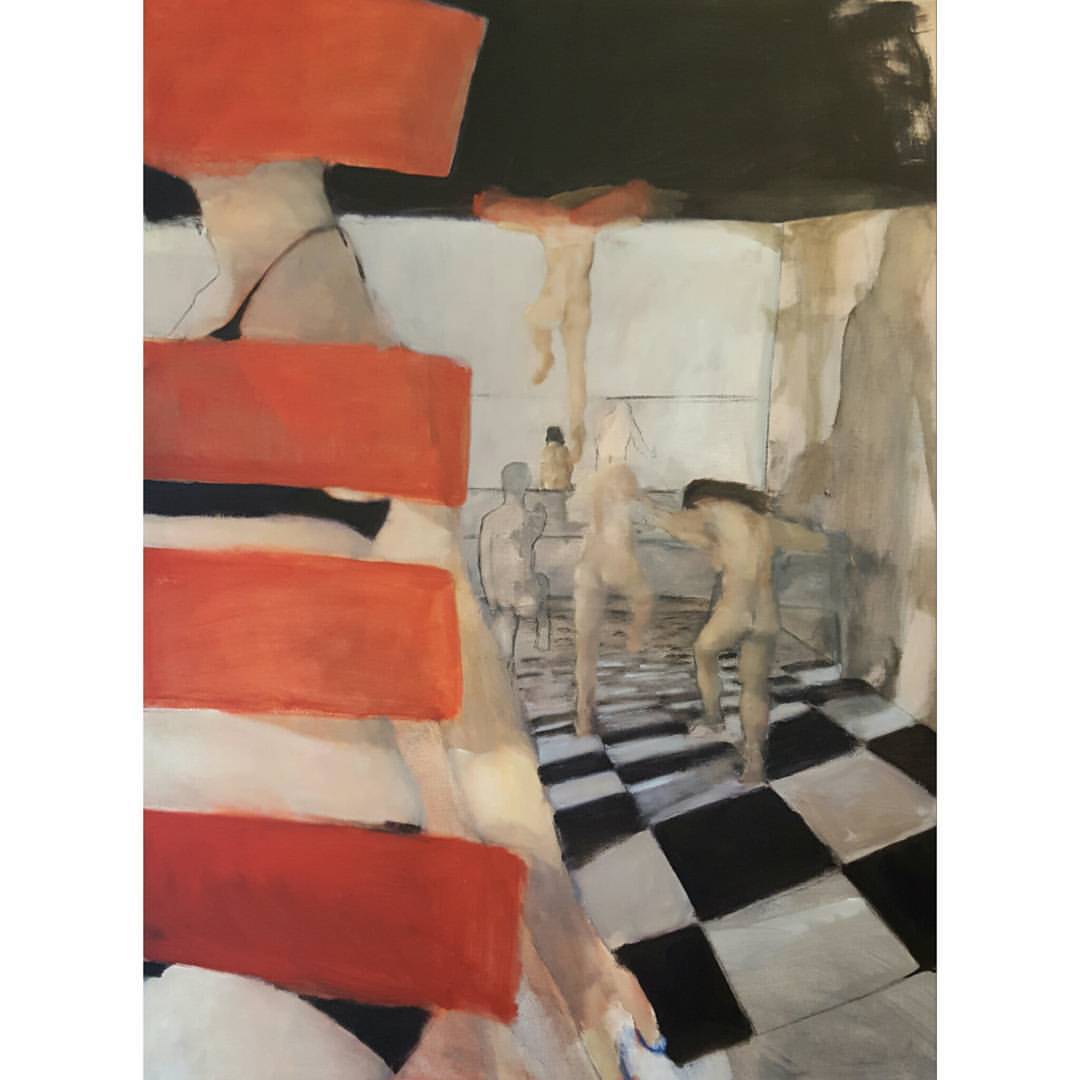This week’s blog post is contributed by Karen Kaapcke, Alan Moverman, and Robert Bunkin. Karen Kaapcke is a painter based in New York City and France. Her paintings and drawings have been exhibited in NYC, across the country, and internationally, and her work has received numerous awards and is in many private collections. Alan Moverman is a versatile pianist, and has been a soloist at New York City Ballet since 2000. He is best known for his collaborative work with dance, and has appeared at arts venues in premieres of major works of Alexei Ratmansky, Justin Peck, and Christopher Wheeldon. Robert Bunkin is a figurative painter, art historian, and was Curator of art at the Staten Island Museum from 2011 to 2017.
On March 16, 2018, a unique program was presented to a standing room-only crowd at The National Opera Center auditorium. Entitled Life’s Stages: A Collaboration, it featured painter Karen Kaapcke and pianist Alan Moverman, with guest cellist Maureen McDermott, and was the product of several years of intense exchange. Moverman performed a select repertoire of pieces by Bach/Busoni, Debussy, Beethoven, Copland, Arvo Pärt, and Bill Evans (Ligeti was also on the program, but time didn’t permit that piece to be performed). Kaapcke’s paintings, which were her responses to those same pieces, were displayed on the walls and projected while the specific piece was performed. A previous iteration had been offered at The Artist Study, a gallery in Southampton, Long Island, where Kaapcke shows her work.
The following interview took place two weeks after the performance.
Robert Bunkin: What was the project’s premise?
Alan Moverman: A number of years ago I conceived of collaborating with artists from other disciplines who could help contextualize a selection of music, help people to understand the music better by providing them with something else to bounce off of other than just my playing. Meeting Karen was great. I got to know her from the neighborhood, then I saw her work on social media, and a collaboration with a local artist seemed like a great opportunity for community-building. And she was game!
Karen Kaapcke: Yeah, so the gameness…initially it was very vague, to do something together: music and painting. It was the right time in my career when I was looking at what I was doing with my work. As a painter you’re in a bubble, alone in your studio. This sounded right when Alan proposed a collaboration to me. Not that I was in a rut, but maybe not challenging myself anew. We’d run into each other and go off on these conversations that would go on and on. I felt that we were on the same page artistically.
Bunkin: You have a musical background: you studied flute, your mother was a dancer, your husband plays the piano, and both your kids studied musical instruments.
Kaapcke: Yes, music is part of my context.
Moverman: She’s very musical.
Bunkin: Alan, do you have any interest in visual art apart from this?
Moverman: Oh yeah, I’m very interested in art. To me 20th century music is more visual than 19th century music. 19th century music is more emotional, but 20th century music evokes images frequently and involves parts of the brain that are more pictorial. So if you look at the program, it’s mostly modern: Pärt, Copland, Ligeti, Debussy. When I play these composers I draw heavily on images, as opposed to Beethoven, where I think it would be a misunderstanding to lean heavily on images.
Bunkin: So tell me a little more about how this project evolved, like where did you meet, and the kinds of conversations you had that led to the crystallization of this particular program.
Moverman: It took place over a fairly long period of time. We would run into each other in the playground. The kids were like 4-5 when we met in that playground. I can’t remember when it turned into an actual thing. I was the one who said, I’m ready to do this, that’s my style.
Kaapcke: Yes, Alan was the instigator. Our conversations always threatened to go on and on; this was pre-social media, so it took a long time. We would find ourselves on the same page artistically, but in different media…then I remember when we friended each other on Facebook, and that’s when you started to see my paintings as opposed to hearing me talk about them. Then you saw a drawing I did and you said this is really musical, based on Schubert.
Moverman: Oh yeah! Well Schubert is very visual.
Kaapcke: So this went on for a couple of years, then you said you were interested in collaborating.
Moverman: Well you were the first person I actually did it with, because I ‘d been thinking about it for years, but this is the first time it actually manifested. One of the artists I wanted to model this on was Christo, because Christo talks about the nitty-gritty of organizing the event as part of the art itself, you can call it the technical part of the collaboration. In order to get the work out there, you have to deal with the world. It’s easier to do that with two people. I never could have done this myself.
Bunkin: A kind of support. I think it’s interesting that artists often don’t support artists in different disciplines, like writers are more concerned with literature, visual artists don’t necessarily listen to music, musicians don’t look at painting, etc.
Moverman: I don’t think other art forms are secondary to your work.
Bunkin: How did you select the repertoire and why, and what piece did you play?
Moverman: The germinative idea was Life Stages, to explore how composers’ compositions reflect the times of life: youth, maturity, old age.
Bunkin: Did the work correlate to their age at the time of the composers’ lives?
Moverman: For example we played late Beethoven, that’s the most obvious, the Opus 111, no. 32, his last piano sonata. And the Copland, in my view was his last real successful composition before he got Alzheimer’s. Piano Fantasy is a nice amalgam of his different styles. Then the Arvo Pärt is a fairly late piece, and the Debussy was a late piece.
Kaapcke: You find an emotional core to the pieces.
Bunkin: How did you get to hear the pieces? Did you select, Alan, or did you both choose?
Moverman: Well we both selected. I’d suggest works and ask, would this work for you?
Kaapcke: Once I accepted the theme, I never said no to any of the pieces Alan suggested, so we really both selected. Alan would send me performances (not his) for me to listen to. The piece that hooked me in was that late Beethoven. I can’t just listen to Beethoven. I need to work.
Moverman: In Beethoven there’s always a sense of meaning, maybe more than any other composer.
Kaapcke: The thematic structure of Life Stages gave me a lot in terms of imagery. I asked myself how this piece articulates a time of life? I never listened to music with that framework before. I work with music all the time, so there must be some influence, but not like this.
Moverman: It must have been hard for you to commit to it, because it’s almost cheesy. When I went to the Rodin exhibition at the Met I discovered that he’d done something similar with Debussy, although I don’t think there was a one-to-one correlation.
Bunkin: So this seems like the right time to ask my next question, which has to do with the concept of synesthesia. There’s a very important line in modern art, late 19th and early 20th century in which synesthesia is a central idea, which inspired abstraction. Did you feel your work was synesthetic or interpretive?
Kaapcke: I love this question! I do respond to music in terms of color. Color is a vibration and sound is a vibration and that’s where they meet. I really tried to immerse myself in this specific piece while I was doing that painting, I wouldn’t listen to anything else. My work is figurative, but the cliché is that the painting associated with music is abstract. Initially I would start with a synesthetic response, like I’d listen and “hear” a pink, for example, and I’d tone the canvas in that pink, then shapes came quickly. But then I’d start to ask myself what are these shapes doing, which is a narrative question, what story does this tell?
Moverman: These paintings, when you look at them, are about what do these paintings have to say? That’s what takes it away from the cheesiness.
Bunkin: So you were living with this music and then you spring-boarded from the synesthetic beginning.
Kaapcke: Yes, there’s a dialogue with the music. But the music, obviously, can stand on its own, and my paintings should stand on their own, apart from the music. Abstract manifestations of music don’t go far enough, not to diminish abstraction. The paintings aren’t reactive, they are really evolved.
Moverman: One of my big things is that I’m very anti-sensual in my music. All art is sensual, so for me the idea that a piece of music has a meaning should be central.

Bunkin: Alan what did you feel you got out of it? Did Karen’s paintings influence your interpretations of the music?
Moverman: I don’t see myself in the same category, because I’m not the creator of the “script.” I don’t create the music. I interpret it. But yes, Karen helped me see certain things, for example, the Beethoven is very visceral, with a sexual violence that I sensed in it, which went against the genteel tradition I’d been trained in, to avoid aggression. Looking at Karen’s interpretation of the Beethoven helped me to get closer to my sense of Beethoven’s meaning. In terms of content I can’t influence the content of the music, I am the servant of the music, I’m influenced by everything I see to be a better vessel for the music. I always assume that the creation is much better than me. I mean Beethoven is like Shakespeare, being submissive to Beethoven is not a terrible thing.
Bunkin: A criticism that’s often leveled at Classical music concerts is that they’re “stuffy” because the concert is very unadorned, the musician appears on the stage and plays, unlike pop concerts with lights, dancers, fireworks, etc. like a 20 ring circus. But I love the plainness of the classical music concert because it focuses more on the aural experience of the music. Watching the audience listening (at your program), they often closed their eyes. Then they would also look around the auditorium to find the piece that was being projected, to correlate the actual piece with the projection (which was sometimes showing a detail) and then go back to purely listening. So there was a tension between these experiences that could be distracting rather than enhancing.
Kaapcke: I had this question too about the audience. It’s perfectly OK that my vision of the music was different than what an audience member might visualize.
Bunkin: Do you feel the collaboration had a significant impact on your work?
Kaapcke: The collaboration raised my game. It changed my painting profoundly. It put me in a position of working outside of myself, beyond my comfort zone.
Moverman: Me too, me too! In my view that was our primary accomplishment: we created a template that can be repeated, it drew people and it was beautiful, those are important things to me.


